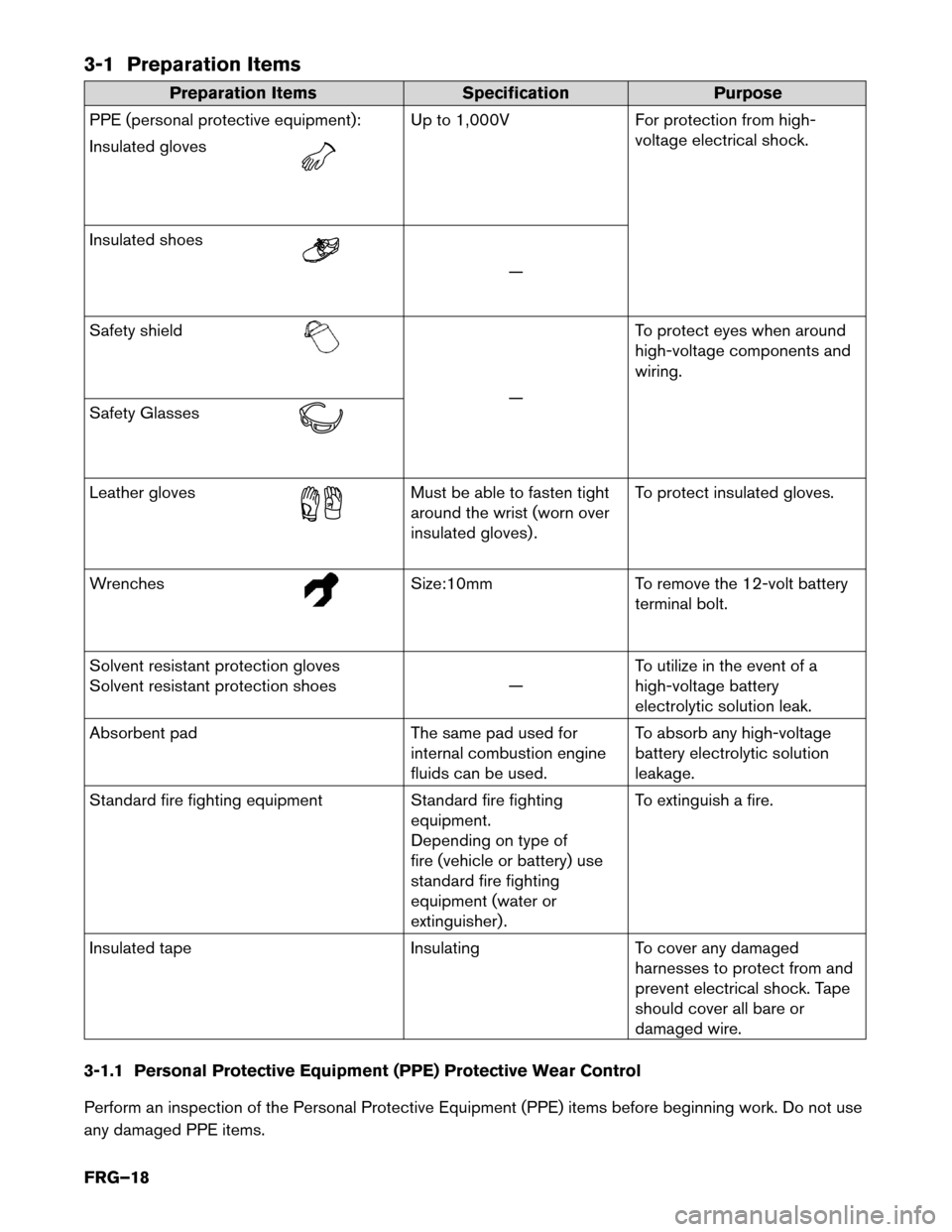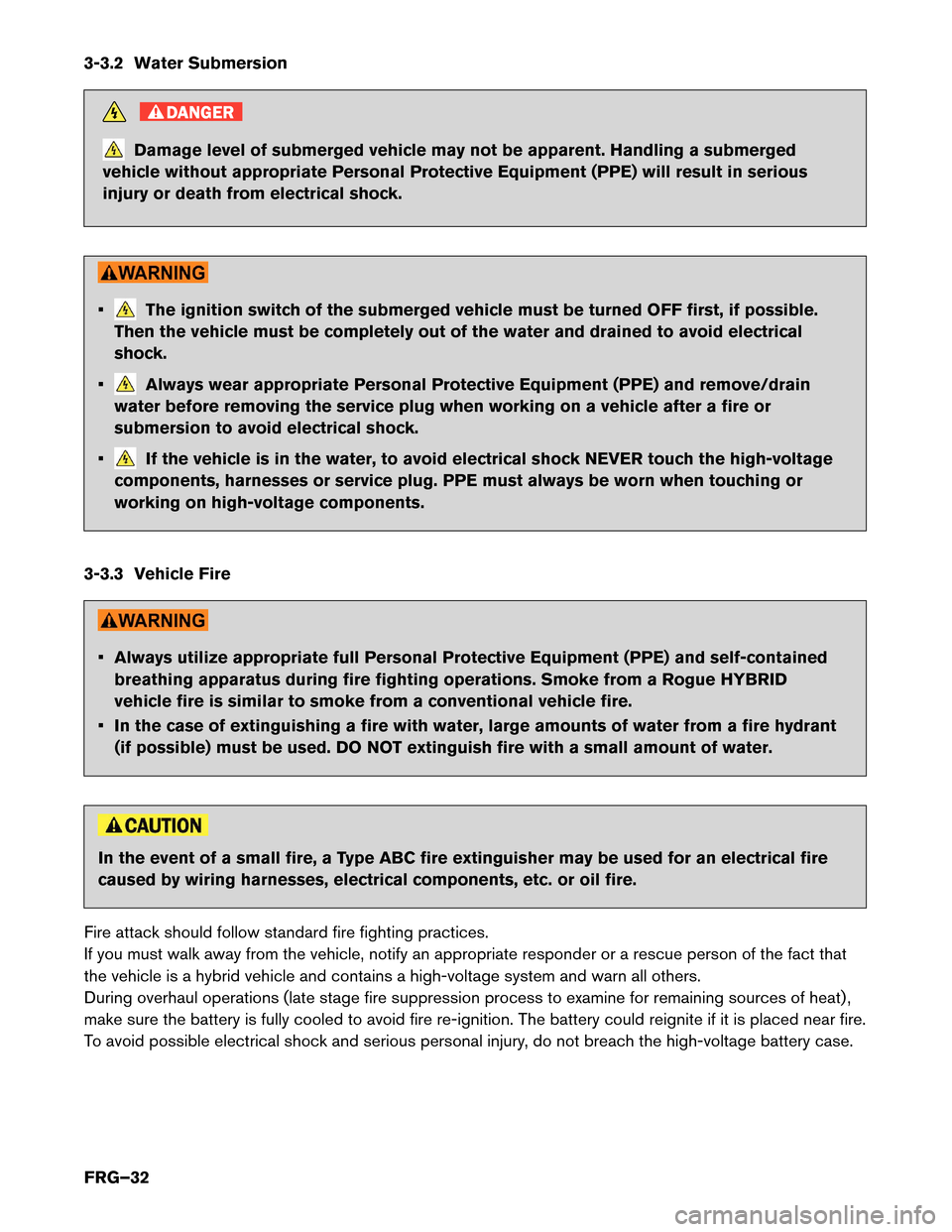wiring NISSAN ROGUE HYBRID 2017 2.G First Responders Guide
[x] Cancel search | Manufacturer: NISSAN, Model Year: 2017, Model line: ROGUE HYBRID, Model: NISSAN ROGUE HYBRID 2017 2.GPages: 46, PDF Size: 6.12 MB
Page 18 of 46

3-1 Preparation Items
Preparation Items
SpecificationPurpose
PPE
(personal protective equipment): Up to 1,000V For protection from high-
voltage electrical shock.
Insulated gloves Insulated shoes
—
Safety
shield —
T
o protect eyes when around
high-voltage components and
wiring.
Safety Glasses Leather gloves Must be able to fasten tight
around
the wrist (worn over
insulated gloves) . To protect insulated gloves.
Wrenches Size:10mm
To remove the 12-volt battery
terminal
bolt.
Solvent resistant protection gloves
Solvent resistant protection shoes —To utilize in the event of a
high-voltage battery
electrolytic solution leak.
Absorbent pad The same pad used for
internal combustion engine
fluids can be used. To absorb any high-voltage
battery electrolytic solution
leakage.
Standard fire fighting equipment Standard fire fighting
equipment.
Depending on type of
fire (vehicle or battery) use
standard fire fighting
equipment (water or
extinguisher) . To extinguish a fire.
Insulated tape InsulatingTo cover any damaged
harnesses to protect from and
prevent electrical shock. Tape
should cover all bare or
damaged wire.
3-1.1 Personal Protective Equipment (PPE) Protective Wear Control
Perform an inspection of the Personal Protective Equipment (PPE) items before beginning work. Do not use
any damaged PPE items.
FRG–18
Page 20 of 46

3-3 How to Handle a Damaged Vehicle at an Accident Scene
NO
TE:
If any air bags have deployed in the following 3 situations, the high-voltage (HV) system has
been designed to automatically shut off at the time of deployment.
The Nissan Rogue HYBRID high-voltage system incorporates capacitors which are energized whenever the
high-voltage system is on. If the high-voltage system is shut down (either through one of the built-in
automatic mechanisms or manually through one of the procedures explained in this FRG) , the capacitors
will begin to gradually discharge. Complete discharge requires approximately 10 minutes after
high-voltage system shut down. It is within this period of time that responders must be most cautious.
When arriving to an incident involving an Nissan Rogue HYBRID, the vehicle should be approached with
caution and inspected for the level of damage. In addition to overall vehicle condition (location and severity
of body damage, air bag deployment, etc.) , the high-voltage system should be assessed specifically. The
locations of the high-voltage component parts are illustrated in this FRG. Refer to 2-2 High-voltage-
Related
and 12-Volt-Related Component Locations and Descriptions (FRG–11) . Appropriate personal pro-
tective
equipment (PPE) must always be worn when approaching a vehicle of unknown condition, as
described in this FRG.
Situation 1) High-voltage (HV) system intact, occupants can be accessed without extrication tools
The HV system can be shut down by following the procedure in this guide, while wearing appropriate PPE.
After HV system shut down, occupant assistance operations can begin immediately, and no wait period
is necessary.
Situation 2) High-voltage (HV) system intact, occupants cannot be accessed without extrication tools
The HV system can be shut down by following the procedure in this guide, while wearing appropriate PPE.
After HV system shut down, absolute care must be taken never to cut through or damage any HV system
wiring, battery or components within approximately ten (10) minutes of HV system shut down,
but occupant assistance operations using extrication equipment can begin immediately. The locations of the
HV component parts are illustrated in this guide.
Situation 3) High-voltage (HV) system damaged
If there is any evidence that the HV system has been compromised (such as arcing/sparking, orange wiring
harnesses cut or damaged, HV component casings damaged, etc.) , the responder may still be at risk of
high-voltage exposure. The vehicle must be approached with extreme caution prior to initiating any system
shut down procedures or rendering assistance to occupants. Appropriate PPE must always be worn as
described in this guide, and the approximate ten (10) minute wait time must be observed after HV
system shut down in order to ensure the system is de-energized.
In rare situations where vehicle damage is very severe, HV system shut down procedures as described in
this guide may not work. In these instances extreme caution and appropriate risk management must be
followed to prevent shock or electrocution to the responder or occupant.
FRG–20
Page 32 of 46

3-3.2 Water Submersion
DANGER
Damage level of submerged vehicle may not be apparent. Handling a submerged
vehicle without appropriate Personal Protective Equipment (PPE) will result in serious
injury or death from electrical shock. • The ignition switch of the submerged vehicle must be turned OFF first, if possible.
Then
the vehicle must be completely out of the water and drained to avoid electrical
shock.
• Always wear appropriate Personal Protective Equipment (PPE) and remove/drain
water
before removing the service plug when working on a vehicle after a fire or
submersion to avoid electrical shock.
• If the vehicle is in the water, to avoid electrical shock NEVER touch the high-voltage
components,
harnesses or service plug. PPE must always be worn when touching or
working on high-voltage components.
3-3.3 Vehicle Fire • Always utilize appropriate full Personal Protective Equipment (PPE) and self-contained
breathing
apparatus during fire fighting operations. Smoke from a Rogue HYBRID
vehicle fire is similar to smoke from a conventional vehicle fire.
• In the case of extinguishing a fire with water, large amounts of water from a fire hydrant (if possible) must be used. DO NOT extinguish fire with a small amount of water. In the event of a small fire, a Type ABC fire extinguisher may be used for an electrical fire
caused
by wiring harnesses, electrical components, etc. or oil fire.
Fire attack should follow standard fire fighting practices.
If you must walk away from the vehicle, notify an appropriate responder or a rescue person of the fact that
the vehicle is a hybrid vehicle and contains a high-voltage system and warn all others.
During overhaul operations (late stage fire suppression process to examine for remaining sources of heat) ,
make sure the battery is fully cooled to avoid fire re-ignition. The battery could reignite if it is placed near fire.
To avoid possible electrical shock and serious personal injury, do not breach the high-voltage battery case.
FRG–32